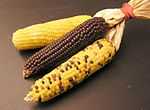Sadza
| Sadza | |
|---|---|
| Type | Porridge |
| Main ingredients | White maize (Mealie-meal) |
|
| |
Sadza in Shona (isitshwala in isiNdebele, pap, vuswa or bogobe in South Africa, or nsima in the Chichewa language of Malawi), Ugali in East Africa, is a cooked cornmeal that is the staple food in Zimbabwe and other parts of southern and eastern Africa. This food is cooked widely in other countries of the region.
Sadza in appearance is a thickened porridge. A thinner form of sadza, "porridge", is cooked with peanut butter or margarine and eaten in the mornings occasionally. The most common form of sadza is made with white maize (Mealie-Meal). This maize meal is referred to as hupfu in Shona or impuphu in Ndebele. Despite the fact that maize is actually an imported food crop to Zimbabwe (circa 1890), it has become the chief source of carbohydrate and the most popular meal for indigenous people. Locals either purchase the meal in retail outlets or produce it in a grinding mill from their own maize.
Zimbabweans prefer white maize meal. During times of famine or hardship they resort to eating yellow maize meal, which is sometimes called "Kenya," because it was once imported from that nation.
Before the introduction of maize, sadza was made from finger millet flour instead.
Sadza is commonly eaten from a communal bowl, but can also be served on separate plates. It is generally eaten with the right hand without the aid of cutlery; often rolled into a ball before being dipped into a variety of condiments such as meat, sauce/gravy, lacto/sour milk or stewed vegetables.
Notable foods eaten with sadza
Meat is known as nyama in Shona.
- Red meat (includes beef, mutton, goat, and game meat)
- Cow hoof (amanqgina, mazondo)
- Oxtail
- Other food stuffs include intestine (Tripe) (offal- ezangaphakathi (includes amathumbu, amaphaphu, isibindi, utwane, ulusu, umbendeni) in Ndebele) known as matumbu, sun-dried vegetables known as uMfushwa/Mufushawa, and many more
- White meat (includes huku or inkukhu - chicken meat, hove - Fish)
- Fish (inhlanzi in Ndebele), including the small dried fish Kapenta
- Mopane worms/madora/amacimbi (edible moth caterpillar)
- Spring greens (known as imibhida in the Ndebele Language, muriwo in the Shona Language)
- Sugar Beans (known as indumba in Ndebele, nyemba Shona)
- Cabbage
- Derere Delele - okra
- Cleome gynandra(ulude in Ndebele)~/nyevhe in Shona
- Pumpkin leaves known as Muboora in shona or ibhokola in Ndebele
- Soured milk natural yogurt (known as amasi in Ndebele or Nguni languages in South Africa, mukaka wakakora in Shona, or lacto)
- Soya Chunks
- Soups and stews
- Sadza and Ox Bone
See also
- Cornmeal
- Fufu (suji)
- Mămăliga
- Nshima
- Polenta
- Ugali
- Chapati
- List of African dishes
- List of porridges
In literature
- Nervous Conditions, Tsitsi Dangarembga, 1988. Ayebia Clark Publishing 2004
References
External links
| ||||||||||||||||||||||||||||||||||||||||||||||
| ||||||||||||||||||
